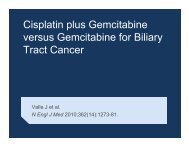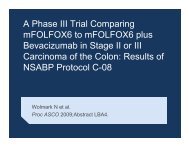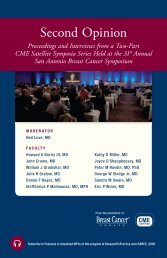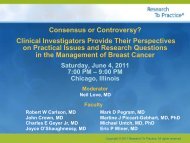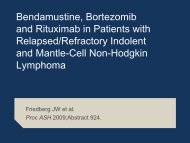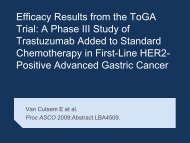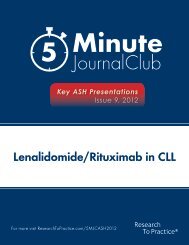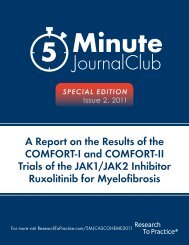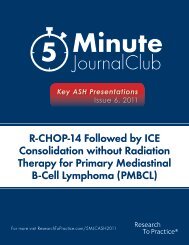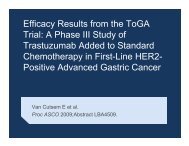Subcutaneous versus Intravenous Administration of Bortezomib in Multiple Myeloma
Downloadable PDF - Research To Practice
Downloadable PDF - Research To Practice
You also want an ePaper? Increase the reach of your titles
YUMPU automatically turns print PDFs into web optimized ePapers that Google loves.
Key ASH PresentationsIssue 7, 2011<strong>Subcutaneous</strong> <strong>versus</strong> <strong>Intravenous</strong><strong>Adm<strong>in</strong>istration</strong> <strong>of</strong> <strong>Bortezomib</strong> <strong>in</strong><strong>Multiple</strong> <strong>Myeloma</strong>For more visit ResearchToPractice.com/5MJCASH2011
CME INFORMATIONOVERVIEW OF ACTIVITYThe annual American Society <strong>of</strong> Hematology (ASH) meet<strong>in</strong>g is unmatched <strong>in</strong> its importance with regard to advancements <strong>in</strong> hematologiccancer and related disorders. It is targeted by many members <strong>of</strong> the cl<strong>in</strong>ical research community as the optimal forum <strong>in</strong> which to unveilnew cl<strong>in</strong>ical data. This creates an environment each year <strong>in</strong> which published results from a plethora <strong>of</strong> ongo<strong>in</strong>g cl<strong>in</strong>ical trials lead to theemergence <strong>of</strong> many new therapeutic agents and changes <strong>in</strong> the <strong>in</strong>dications for exist<strong>in</strong>g treatments across virtually all malignant andbenign hematologic disorders. As onl<strong>in</strong>e access to posters and plenary presentations is not currently available, a need exists for additionalresources to distill the <strong>in</strong>formation presented at the ASH annual meet<strong>in</strong>g for those cl<strong>in</strong>icians unable to attend but desir<strong>in</strong>g to rema<strong>in</strong> up todate on the new data released there. To bridge the gap between research and patient care, this CME activity will deliver a serial review<strong>of</strong> the most important emerg<strong>in</strong>g data sets from the latest ASH meet<strong>in</strong>g, <strong>in</strong>clud<strong>in</strong>g expert perspectives on how these new evidence-basedconcepts can be applied to rout<strong>in</strong>e cl<strong>in</strong>ical care. This activity will assist medical oncologists and other cancer cl<strong>in</strong>icians <strong>in</strong> the formulation <strong>of</strong>optimal cl<strong>in</strong>ical management strategies for hematologic cancer.LEARNING OBJECTIVES• Compare and contrast the efficacy and safety outcomes with subcutaneous <strong>versus</strong> <strong>in</strong>travenous bortezomib adm<strong>in</strong>istration <strong>in</strong> multiplemyeloma.• Counsel patients with multiple myeloma about the known benefits and risks <strong>of</strong> bortezomib when adm<strong>in</strong>istered subcutaneously and<strong>in</strong>travenously.ACCREDITATION STATEMENTResearch To Practice is accredited by the Accreditation Council for Cont<strong>in</strong>u<strong>in</strong>g Medical Education to provide cont<strong>in</strong>u<strong>in</strong>g medical educationfor physicians.CREDIT DESIGNATION STATEMENTResearch To Practice designates this educational activity for a maximum <strong>of</strong> 0.25 AMA PRA Category 1 Credits. Physicians should onlyclaim credit commensurate with the extent <strong>of</strong> their participation <strong>in</strong> the activity.HOW TO USE THIS CME ACTIVITYThis CME activity conta<strong>in</strong>s slides and edited commentary. To receive credit, the participant should review the slide presentation, read thecommentary and complete the Educational Assessment and Credit Form located at CME.ResearchToPractice.com.CONTENT VALIDATION AND DISCLOSURESResearch To Practice (RTP) is committed to provid<strong>in</strong>g its participants with high-quality, unbiased and state-<strong>of</strong>-the-art education. Weassess potential conflicts <strong>of</strong> <strong>in</strong>terest with faculty, planners and managers <strong>of</strong> CME activities. Real or apparent conflicts <strong>of</strong> <strong>in</strong>terest areidentified and resolved through a conflict <strong>of</strong> <strong>in</strong>terest resolution process. In addition, all activity content is reviewed by both a member <strong>of</strong>the RTP scientific staff and an external, <strong>in</strong>dependent physician reviewer for fair balance, scientific objectivity <strong>of</strong> studies referenced andpatient care recommendations.FACULTY — The follow<strong>in</strong>g faculty (and their spouses/partners)reported real or apparent conflicts <strong>of</strong> <strong>in</strong>terest, which have beenresolved through a conflict <strong>of</strong> <strong>in</strong>terest resolution process:Rafael Fonseca, MDConsultant, Pr<strong>of</strong>essor <strong>of</strong> Medic<strong>in</strong>eMayo Cl<strong>in</strong>ic ArizonaDeputy Director, Mayo Cl<strong>in</strong>ic Cancer CenterScottsdale, ArizonaConsult<strong>in</strong>g Agreements: Amgen Inc, Bristol-Myers SquibbCompany, Celgene Corporation, Genzyme Corporation, MedtronicInc, Otsuka Pharmaceutical Co Ltd; Paid Research: CelgeneCorporation, Onyx Pharmaceuticals Inc.EDITOR — Dr Love is president and CEO <strong>of</strong> Research To Practice,which receives funds <strong>in</strong> the form <strong>of</strong> educational grants todevelop CME activities from the follow<strong>in</strong>g commercial <strong>in</strong>terests:Abraxis BioScience Inc, a wholly owned subsidiary <strong>of</strong> CelgeneCorporation, Allos Therapeutics, Amgen Inc, AstraZenecaPharmaceuticals LP, Aureon Laboratories Inc, Bayer HealthCarePharmaceuticals/Onyx Pharmaceuticals Inc, Biogen Idec,Boehr<strong>in</strong>ger Ingelheim Pharmaceuticals Inc, Bristol-Myers SquibbCompany, Celgene Corporation, Cephalon Inc, Daiichi Sankyo Inc,Dendreon Corporation, Eisai Inc, EMD Serono Inc, GenentechBioOncology, Genomic Health Inc, Lilly USA LLC, Millennium— The Takeda Oncology Company, Mundipharma InternationalLimited, Myriad Genetics Inc, Novartis PharmaceuticalsCorporation, OSI Oncology, San<strong>of</strong>i-Aventis and Seattle Genetics.RESEARCH TO PRACTICE STAFF AND EXTERNAL REVIEWERS— The scientific staff and reviewers for Research To Practice haveno real or apparent conflicts <strong>of</strong> <strong>in</strong>terest to disclose.This educational activity conta<strong>in</strong>s discussion <strong>of</strong> publishedand/or <strong>in</strong>vestigational uses <strong>of</strong> agents that are not <strong>in</strong>dicated bythe Food and Drug <strong>Adm<strong>in</strong>istration</strong>. Research To Practice doesnot recommend the use <strong>of</strong> any agent outside <strong>of</strong> the labeled<strong>in</strong>dications. Please refer to the <strong>of</strong>ficial prescrib<strong>in</strong>g <strong>in</strong>formationfor each product for discussion <strong>of</strong> approved <strong>in</strong>dications,contra<strong>in</strong>dications and warn<strong>in</strong>gs. The op<strong>in</strong>ions expressed are those<strong>of</strong> the presenters and are not to be construed as those <strong>of</strong> thepublisher or grantors.This program is supported by educational grants from AllosTherapeutics, Celgene Corporation, Millennium — The TakedaOncology Company, Novartis Pharmaceuticals Corporation, OnyxPharmaceuticals Inc and Seattle Genetics.Last review date: March 2011Expiration date: March 2012
Key ASH PresentationsIssue 7, 2011Click here for papers on proteasome <strong>in</strong>hibitors and IMiDs <strong>in</strong> multiple myelomaIn the last issue <strong>of</strong> our San Antonio-focused edition <strong>of</strong> this series, we op<strong>in</strong>ed aboutthe lack <strong>of</strong> recent research progress <strong>in</strong> breast cancer and looked to a tumor occurr<strong>in</strong>gat one tenth the frequency for <strong>in</strong>spiration and hope. <strong>Multiple</strong> myeloma affectsapproximately 20,000 new patients <strong>in</strong> the US annually and for a long time was adisease stuck for new therapeutic options. However, fairly recently two classes <strong>of</strong>treatments have stormed onto the scene — immunomodulatory agents (IMiDs) andproteasome <strong>in</strong>hibitors — mak<strong>in</strong>g myeloma perhaps the fastest mov<strong>in</strong>g and mostdynamic area <strong>in</strong> oncology.It’s difficult to figure out exactly what led to this encourag<strong>in</strong>g state <strong>of</strong> affairs, but those<strong>in</strong> the middle <strong>of</strong> it all claim that an effective partnership between academia, <strong>in</strong>dustryand unusually active advocacy groups made it happen. One might also consider thatperhaps there was a unique and fortunate tumor biopharmacology at work here.Regardless <strong>of</strong> the source <strong>of</strong> this important progress, currently, lenalidomide, bortezomiband to a lesser extent thalidomide are help<strong>in</strong>g patients with myeloma live longer andfeel better. Perhaps even more importantly, two excit<strong>in</strong>g but not yet approved agents— carfilzomib and pomalidomide — seem poised to further transform the classicparadigms <strong>of</strong> this enigmatic disease. Several related ASH data sets provide a glimpse <strong>of</strong>what the future may hold for these unique classes <strong>of</strong> agents:1. <strong>Subcutaneous</strong> bortezomibA large (n = 222) <strong>in</strong>ternational Phase III study demonstrated similar efficacy butmarkedly less neurotoxicity when SC bortezomib was compared to IV adm<strong>in</strong>istration<strong>in</strong> the refractory sett<strong>in</strong>g. These <strong>in</strong>trigu<strong>in</strong>g f<strong>in</strong>d<strong>in</strong>gs suggest that higher peak druglevels occurr<strong>in</strong>g with IV treatment may correlate with neuronal damage and thatthe SC approach may <strong>of</strong>fer obvious patient care advantages. Investigators are veryquickly attempt<strong>in</strong>g to further validate this <strong>in</strong>terest<strong>in</strong>g concept. Another importantcl<strong>in</strong>ical research avenue with bortezomib as presented by Antonio Palumbo and othersis weekly dos<strong>in</strong>g <strong>of</strong> the agent, which seems to be equally efficacious and much lessneurotoxic2. PomalidomideTwo more Phase II studies <strong>of</strong> this fasc<strong>in</strong>at<strong>in</strong>g and well-tolerated IMiD comb<strong>in</strong>ed withdexamethasone demonstrated substantial antitumor effect <strong>in</strong> almost half <strong>of</strong> thetrial participants, all <strong>of</strong> whom were considered refractory to both bortezomib andlenalidomide. Cl<strong>in</strong>icians seem ready to use this drug now.
3. CarfilzomibAga<strong>in</strong>, significant activity was seen <strong>in</strong> later-l<strong>in</strong>e treatment <strong>in</strong> two separate Phase IIstudies, with m<strong>in</strong>imal neurotoxicity, <strong>in</strong>clud<strong>in</strong>g a lack <strong>of</strong> worsen<strong>in</strong>g <strong>of</strong> this challeng<strong>in</strong>gadverse effect <strong>in</strong> patients with basel<strong>in</strong>e peripheral neuropathy. A current compell<strong>in</strong>gPhase III study is randomly assign<strong>in</strong>g patients to either CRD or Rd <strong>in</strong> the search forthe “R-CHOP” <strong>of</strong> myeloma. As with pomalidomide, oncologists aga<strong>in</strong> seem ready and<strong>in</strong>terested <strong>in</strong> utiliz<strong>in</strong>g this agent.Next up on our f<strong>in</strong>al ASH 5-M<strong>in</strong>ute Journal Club: Papers on MDS, AML and my personalfavorite current topic <strong>in</strong> oncology, AP.Neil Love, MDResearch To PracticeMiami, FloridaResearch To Practice is accredited by the Accreditation Council for Cont<strong>in</strong>u<strong>in</strong>g Medical Education toprovide cont<strong>in</strong>u<strong>in</strong>g medical education for physicians.Research To Practice designates each educational activity for a maximum <strong>of</strong> 0.25 AMA PRACategory 1 Credits TM . Physicians should only claim credit commensurate with the extent <strong>of</strong> theirparticipation <strong>in</strong> each activity.This program is supported by educational grants from Allos Therapeutics, Celgene Corporation,Millennium — The Takeda Oncology Company, Novartis Pharmaceuticals Corporation, OnyxPharmaceuticals Inc and Seattle Genetics.Research To PracticeOne Biscayne Tower2 South Biscayne Boulevard, Suite 3600Miami, FL 33131This email was sent to you by Dr Neil Love and Research To Practice. To unsubscribe to futureemail requests and announcements, click here. To unsubscribe from all email communications,<strong>in</strong>clud<strong>in</strong>g CME/CNE activities sent by Research To Practice, click here.To update your <strong>in</strong>formation on our current distribution lists, click here.
<strong>Subcutaneous</strong> <strong>versus</strong> <strong>Intravenous</strong> <strong>Adm<strong>in</strong>istration</strong> <strong>of</strong><strong>Bortezomib</strong> <strong>in</strong> <strong>Multiple</strong> <strong>Myeloma</strong>Presentation discussed <strong>in</strong> this issueMoreau P et al. A phase 3 prospective, randomized, <strong>in</strong>ternational study (MMY-3021) compar<strong>in</strong>g subcutaneous and <strong>in</strong>travenous adm<strong>in</strong>istration <strong>of</strong> bortezomib <strong>in</strong>patients with relapsed multiple myeloma. Proc ASH 2010;Abstract 312.Slides from a presentation at ASH 2010 and transcribed commentsfrom a recent <strong>in</strong>terview with Rafael Fonseca, MD (12/22/10)For more visit ResearchToPractice.com/5MJCASH2011
For more visit ResearchToPractice.com/5MJCASH2011
For more visit ResearchToPractice.com/5MJCASH2011
For more visit ResearchToPractice.com/5MJCASH2011
For more visit ResearchToPractice.com/5MJCASH2011



